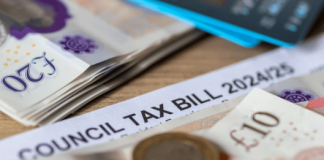IT is an “urban myth” that Bradford Council does a poor job of collecting Council Tax – according to its leader.
Councillor Susan Hinchcliffe said new figures show that Bradford was comparable to other similar Council areas in the amount of Council Tax it collects – a figure which stood at 94 per cent in the past year.
But it still means million of pounds of Council tax goes uncollected each year.
Collection rates were discussed at a meeting of Bradford Council’s Executive earlier this month, when members were presented with an update on the Bradford Plan.
The document sets a number of targets for the District, ranging from life expectancy to educational attainment, and details how the Council has fared in meeting those targets.
One of the targets in the plan is to increase the percentage of Council Tax collected.
The “in year” target collection rate, the percentage of Council Tax collected in the year it is owed, is 94 per cent.
In the past year (2024/25) in Bradford the collection rate was 94.04 per cent – just meeting the target.
But the figure is slightly down from last year – when it stood at 94.22 per cent, and is at its lowest level in over five years.
The Council says it pursues Council Tax non-payment, but some of the money may not be collected in the year it is owed.
And some debts may eventually be written off in cases where the Council cannot track the taxpayer or if they have died.

Image: Bradford Council
Referring to the local plan at a meeting of the Council’s Executive earlier this month, Cllr Hinchcliffe said: “This is a document that all Councillors should read.
“It is a chance to pause and look back at where we’ve been and where we are headed next.
“On a basic level I’m pleased to see that we are collecting 94 per cent of Council Tax.
“Sometimes there are urban myths that in Bradford we don’t collect a lot of the Council Tax owed to us, but this shows we very much collect near the National average and in line with other local authorities.”
The Council’s inability to collect 100 per cent of the Council Tax it is owed has been cited by some as one reason the Council has faced a growing budget deficit in recent years.
Most recent figures published by the UK Government this Summer show that on average in year collection rates for English Councils stood at 95.9 per cent.
The average collection rates for Metropolitan District Councils stood at 93.6 per cent while the average for unitary authorities was 96 per cent.
The Bradford Plan document presented to the meeting explains why collection rates are not 100 per cent, saying: “A growing property base means there are more accounts to collect from.
“The cost of living crisis, despite Council Tax Reduction, has increased financial pressure on some low-income households.
“Council Tax administration is increasingly complex, with rising volumes of queries and disputes over charges, premiums, exemptions, exceptions, and discounts — all of which hinder timely collection.”
The Council’s Corporate Scrutiny Committee was given an update on Council Tax collection earlier this Summer.
Members were told that Tax owed in one year is sometimes not collected for several years.
The in year collection rate for 2023/24 was 94.2 per cent, but since the end of that tax year that rate has risen to 95.93 per cent.
The in year collection rate for 2020/21 was 94.2 per cent, but this figure has since risen to 98 per cent.
Despite ongoing efforts to collect Council Tax, the report said millions of pounds a year is regularly “written off” as being impossible to collect.
Last year around 1.3 per cent of Council Tax payments worth £3.99m were written off.
In 2021/22 the figure was as high as 2.36 per cent (£6.11m).
Explaining the reason debt is sometimes written off, the report said: “There will be some debt, in both Business Rates and Council Tax that becomes irrecoverable, and this could be because of the following reasons:
- Taxpayer has died and there is no money or assets available to pay outstanding debts
- Taxpayer’s whereabouts is no longer known, and they cannot be traced
- Taxpayer is bankrupt or insolvent
- Taxpayer has a Debt Relief Order or an Involuntary Voluntary Arrangement.”




